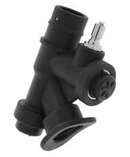All the o rings in the world
Hi Ministry,
I have been collecting O-rings over the last ten years. Batteries are easy to come by while you are in the wilds. Most everyone has a spare battery. Not the O-rings that seal the battery compartment.
Onboard Vision, a diver flooded his computer's battery compartment. I did not have the battery for his computer. Someone else did. I had an O-ring, that according to my mil-spec-mark-7 eyeball was an exact match. Problem solved.
Remember, the donated battery would have lasted less than a dive with the same failed O-ring that caused the flood in the first place. It was a .04 cent part and so small and light weight that an airliner does not even feel it at take-off or decelling after landing.
Just yesterday, I was looking for O-rings for our Hollis dive lights. Hollis was going through an ownership change and was unresponsive. The lights came with some spares. But nowhere was there a description of the O-ring itself.
I micrometered and calipered the O-ring and found them at
theOringstore.com I found my replacement O-rings for my Oceanic (Pelagic Pressure Systems/Aqua Lung,
Shearwater) sender. The minimum order for one of the O-rings was huge. So I bought a kit which has 95% of the O-rings I regularly use for scuba in relatively large quantities of each. Some of the O-rings in this kit are so close in size, that they could be used in a pinch if the proper O-ring has been used up. The kit that I bought has hundreds more O-rings than offerings from an LDS or on-line dive retailer. An Oceanic battery kit with one battery and one O-ring costs the same as this entire kit. They are Buna-N, duro 70 O-rings.
When I replace batteries, I always like to use an O-ring that is fresh, supple, not deformed, nor damaged. They are stupid cheap. I always use KY for O-rings, either Christo or petroleum-free silicone grease (and I have both in my save-a-dive kit.
My wife's back-up computer had what we thought was a fresh battery. It was dying quickly. We were at LCBR (not many purchase options for spares there). I had two spare batteries, the computer's spanner wrench, and a handful of new O-rings. Problem solved.
I also carry tools, IP gauge, batteries, masks, and some fin straps. And, specialty tools for scuba equipment.
In a water resistant bag, my kit weighs 2 lbs 5 ounces. We were restricted to a 55 pound checked bag and a 15 pound carry-on while flying on the DE Haviland Twin Otter AC from Grand Cayman to Little Cayman. My Save-a-dive kit made the trip with no issues. I even brought my pony/bailout bottle with its regulator (my bailout always travels with a trans-fill whip).
Why not!

m





